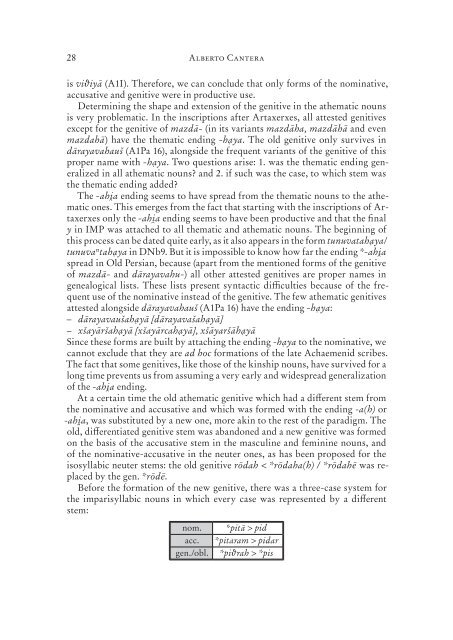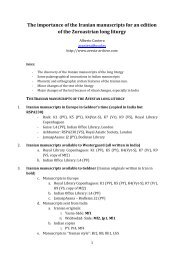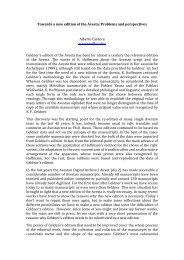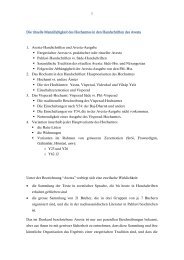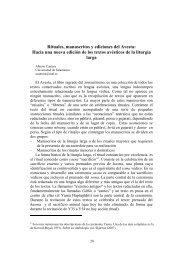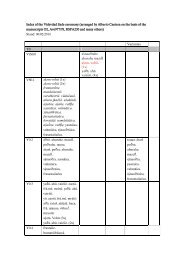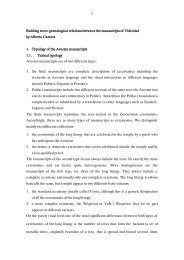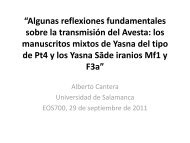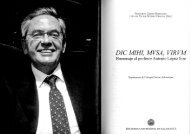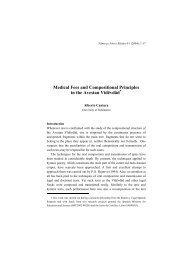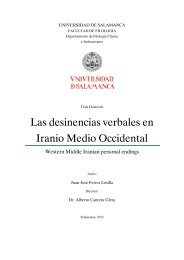On the History of the Middle Persian Nominal Inflection
On the History of the Middle Persian Nominal Inflection
On the History of the Middle Persian Nominal Inflection
Create successful ePaper yourself
Turn your PDF publications into a flip-book with our unique Google optimized e-Paper software.
28 Alberto Cantera<br />
is viϑiyā (A1I). Therefore, we can conclude that only forms <strong>of</strong> <strong>the</strong> nominative,<br />
accusative and genitive were in productive use.<br />
Determining <strong>the</strong> shape and extension <strong>of</strong> <strong>the</strong> genitive in <strong>the</strong> a<strong>the</strong>matic nouns<br />
is very problematic. In <strong>the</strong> inscriptions after Artaxerxes, all attested genitives<br />
except for <strong>the</strong> genitive <strong>of</strong> mazdā- (in its variants mazdāha, mazdāhā and even<br />
mazdahā) have <strong>the</strong> <strong>the</strong>matic ending -hạya. The old genitive only survives in<br />
dārayavahauš (A1Pa 16), alongside <strong>the</strong> frequent variants <strong>of</strong> <strong>the</strong> genitive <strong>of</strong> this<br />
proper name with -hạya. Two questions arise: 1. was <strong>the</strong> <strong>the</strong>matic ending generalized<br />
in all a<strong>the</strong>matic nouns and 2. if such was <strong>the</strong> case, to which stem was<br />
<strong>the</strong> <strong>the</strong>matic ending added<br />
The -aha ending seems to have spread from <strong>the</strong> <strong>the</strong>matic nouns to <strong>the</strong> a<strong>the</strong>matic<br />
ones. This emerges from <strong>the</strong> fact that starting with <strong>the</strong> inscriptions <strong>of</strong> Artaxerxes<br />
only <strong>the</strong> -aha ending seems to have been productive and that <strong>the</strong> final<br />
y in IMP was attached to all <strong>the</strong>matic and a<strong>the</strong>matic nouns. The beginning <strong>of</strong><br />
this process can be dated quite early, as it also appears in <strong>the</strong> form tunuvatahạya/<br />
tunuva n tahạya in DNb9. But it is impossible to know how far <strong>the</strong> ending *-aha<br />
spread in Old <strong>Persian</strong>, because (apart from <strong>the</strong> mentioned forms <strong>of</strong> <strong>the</strong> genitive<br />
<strong>of</strong> mazdā- and dārayavahu-) all o<strong>the</strong>r attested genitives are proper names in<br />
genealogical lists. These lists present syntactic difficulties because <strong>of</strong> <strong>the</strong> frequent<br />
use <strong>of</strong> <strong>the</strong> nominative instead <strong>of</strong> <strong>the</strong> genitive. The few a<strong>the</strong>matic genitives<br />
attested alongside dārayavahauš (A1Pa 16) have <strong>the</strong> ending -hạya:<br />
–– dārayavaušahạyā [dārayavašahạyā]<br />
–– xšayāršahạyā [xšayārcahạyā], xšāyaršāhạyā<br />
Since <strong>the</strong>se forms are built by attaching <strong>the</strong> ending -hạya to <strong>the</strong> nominative, we<br />
cannot exclude that <strong>the</strong>y are ad hoc formations <strong>of</strong> <strong>the</strong> late Achaemenid scribes.<br />
The fact that some genitives, like those <strong>of</strong> <strong>the</strong> kinship nouns, have survived for a<br />
long time prevents us from assuming a very early and widespread generalization<br />
<strong>of</strong> <strong>the</strong> -aha ending.<br />
At a certain time <strong>the</strong> old a<strong>the</strong>matic genitive which had a different stem from<br />
<strong>the</strong> nominative and accusative and which was formed with <strong>the</strong> ending -a(h) or<br />
-aha, was substituted by a new one, more akin to <strong>the</strong> rest <strong>of</strong> <strong>the</strong> paradigm. The<br />
old, differentiated genitive stem was abandoned and a new genitive was formed<br />
on <strong>the</strong> basis <strong>of</strong> <strong>the</strong> accusative stem in <strong>the</strong> masculine and feminine nouns, and<br />
<strong>of</strong> <strong>the</strong> nominative-accusative in <strong>the</strong> neuter ones, as has been proposed for <strong>the</strong><br />
isosyllabic neuter stems: <strong>the</strong> old genitive rōdah < *rōdaha(h) / *rōdahē was replaced<br />
by <strong>the</strong> gen. *rōdē.<br />
Before <strong>the</strong> formation <strong>of</strong> <strong>the</strong> new genitive, <strong>the</strong>re was a three-case system for<br />
<strong>the</strong> imparisyllabic nouns in which every case was represented by a different<br />
stem:<br />
nom.<br />
acc.<br />
gen./obl.<br />
*pitā > pid<br />
*pitaram > pidar<br />
*piϑrah > *pis<br />
03_Cantera.indd 28 05.02.2009 17:45:57


